
Driving along the Amalfi coast
Pastel-colored villages, magical views and amazing food.
The Amalfi Coast, south of Naples in southern Italy, often heads polls of the most beautiful, romantic locations in Europe. A Unesco World Heritage Site, its tiny, pastel-colored villages are among the most photographed in Italy.
Originally built by the Romans, it snakes its way between delightful, small villages. San Pietro to Vietri sul Mare, a 50km stretch, takes about two hours, but the best way to enjoy it most is by taking your time. If the views are magnificent, the drive itself is pretty nerve-jangling. We drive with a mix of trepidation and delight along the narrow, twisting road, with just a low stone wall separating us from the sea 100m below.
Fortunately, the traffic moves slowly and after a few kilometers you’ve almost become familiar with the road and the traffic, and can enjoy the journey in full. The best advice is to take it easy and stop as often as you can – you won’t regret it. Enjoy the views, have a wander around the small villages, order an espresso and eat a mozzarella salad for lunch. And always keep in mind that the journey itself is the goal.
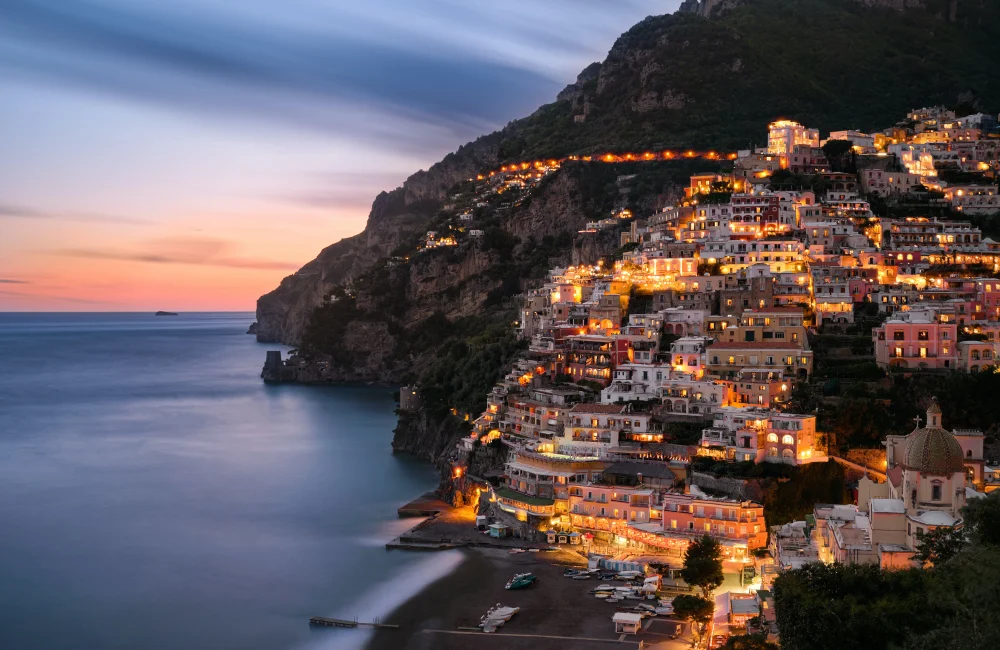
Positano
Positano is the most enchanting village on the Amalfi Coast with stunning pastel-colored houses that hug the cliffs. Artists and authors first discovered the village in the early 1950s, and many of them wanted to keep it a secret. One of them was Nobel laureate John
Steinbeck, who found his way here by chance in 1952 and wrote the following in Harper’s Bazaar: “Nearly always, when you find a place as beautiful as Positano, your impulse is to conceal it. You think, ‘If I tell anyone, it will become crowded with tourists and they will ruin it.’” Steinbeck didn’t manage to keep Positano a secret, but at least in one way the village is indestructible – no new construction is permitted, so the town with 3,500 permanent residents can never get any bigger.
There are plenty of studios, galleries and designer stores here today, and no end of small, intimate restaurants. However, the number of hotels, the narrow coastal road and lack of parking spaces mean there’s only ever room for a limited number of visitors at any one time.
Ristorante Bruno
Pavement tables with views over the beach. Eat an Italian potato salad with anchovies and capers. You’re paying as much for the view as for the food itself, but it’s certainly worth it. Read more here.

Hotel Casa Albertina
Enjoy fabulous views over the sea, especially at sunset. Book your stay here.

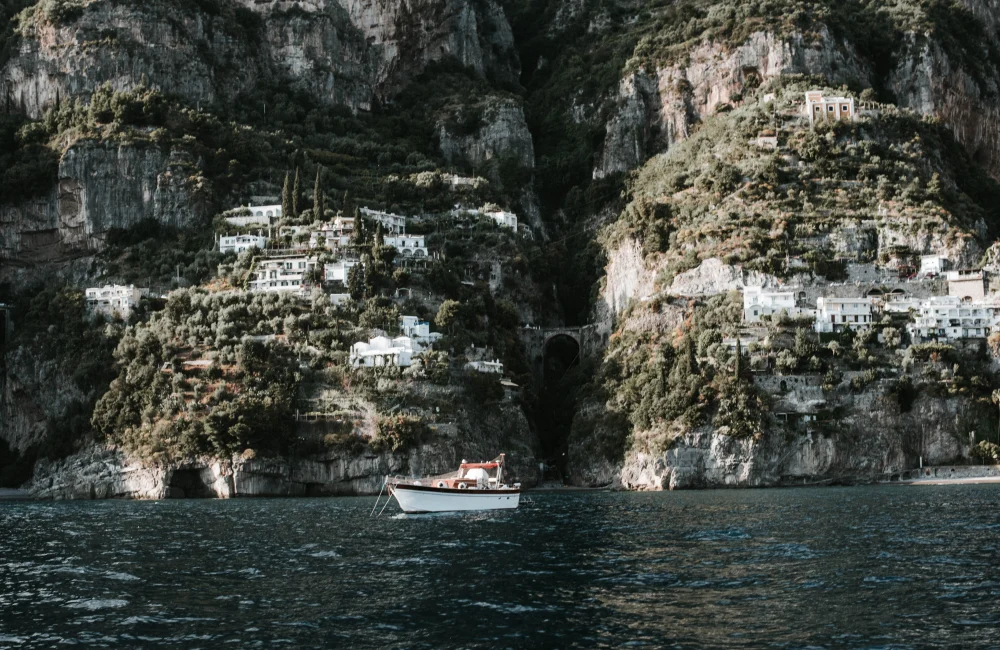
Praiano
We continue to the neighboring village of Praiano, one of the less well-known parts of the Amalfi Coast – and one that proves to be a genuine pearl. Casa Angelina, a minimalist luxury hotel is blasted into the rock. It’s like stepping inside a giant cream cake, where the furniture, walls, ceilings and floors are chalk white. The contrast with the fantastic views of the clear blue sea and equally blue sky is an -experience in itself. It’s here we meet Annarita Aprea:
“It was only when I started working here at the hotel 10 years ago, that I discovered Praiano’s unspoiled charm and authenticity, in contrast to Positano and Amalfi, where there are so many tourists.”
Even though Aprea admits she’s not that enamored with driving along the twisting roads, she’s still starstruck by the beauty and idyllic setting here.
“I must confess that I often tell myself how lucky I am to live and work here,” she smiles.
There aren’t many sandy beaches along the Amalfi Coast, which is why they’ve built large concrete jetties straight out from the cliff in several places. Cala Gavitella Beach Club, which is owned by the Casa Angelina Hotel, is one of the most delightful. Here, you can order drinks, lighter lunches and ice cream – their specialty, sorbetto al limone di Praiano, a lemon sorbet from Praiano, is not to be missed.
“Then, it’s simply a case of throwing yourself into the clear blue water,” says Emar, a worker at Cala Gavitella.
Making your way to the beach is a bit of an adventure in itself. The hotel elevator takes you halfway down, after which you have to navigate 200 steps, about the height of a ten-story building, before you reach the sea. If you want to go straight up to the village of Praiano after your swim, you have a 400-step climb. It’s a genuine workout session. Alternatively, you can stay at the hotel and enjoy the views from beside the pool, under the shade of the lemon trees. That’s pretty delightful, too.
Restaurant M'ama
Seafood restaurant by the sea, where the dishes are small works of art in their own right. Read more here.

Casa Angelina
Stunning, all-white designer hotel with the best views over the Amalfi Coast. Book your stay here.

Annarita Aprea's top 3 tips for Praiano
– Take a boat trip. Rent a small boat and cruise along the coast, explore some of the hidden caves and enjoy a delicious meal at one of the restaurants that can only be reached by sea, such as La Conca Del Sogno, in the tiny bay of Nerano Da Adolfo in Laurito.
– Spend an afternoon in the ancient town of Ravello, with its Roman villas, Villa Rufolo and Villa Cimbrone.
– The best time to visit the Amalfi Coast is in late September and the first two weeks of October. The Mediterranean is still warm and the prices are lower then.
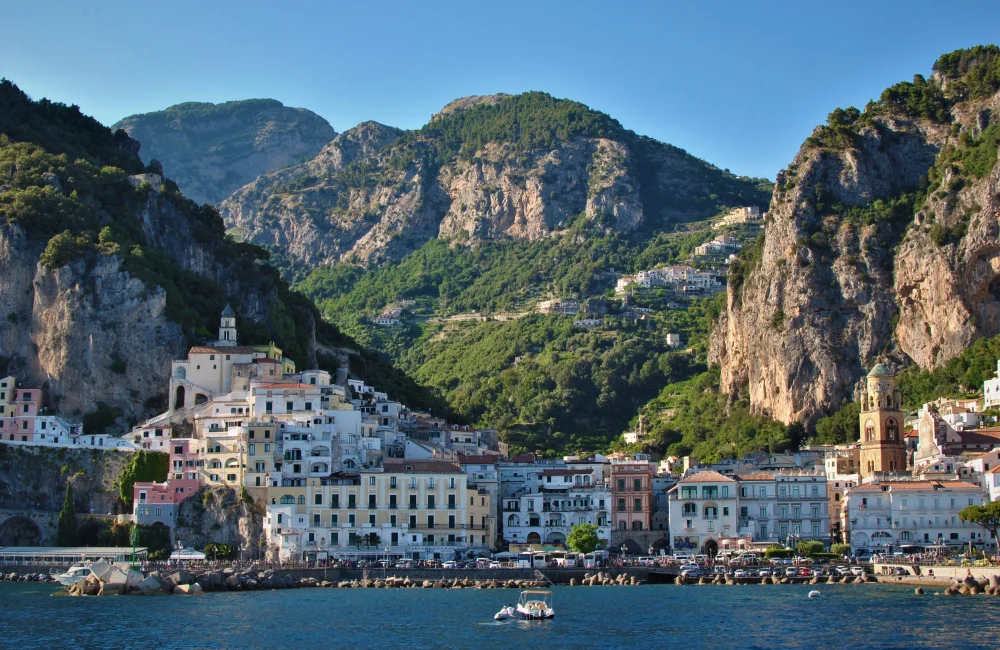
Amalfi
The beaches in the center of Amalfi are packed during summer, and the cooling and enticing crystal clear water is delightful to swim in. In the nearby harbor is a statue of Flavio Gioia, one of the town’s most famous sons, credited with perfecting the sailor’s compass, or at least of refining the Chinese invention and introducing it to Europe.
After a simple lunch at one of the beach restaurants, take a stroll around the beautiful piazza with its splendid cathedral, Doumo San Andrea, that houses the relics of Saint -Andrew the Apostle.
On Piazza Doumo, we each order a cappuccino at the fabled Pansa Amalfi café and are given a history lesson at the same time. On a cliff high above the town is a Capuchin monastery, that’s now a hotel. Legend has it that the Capuchin monks who lived there in the 16th century were the first to pour milk into their coffee, consequently creating the drink we know today as cappuccino.
Pasticceria Caffetteria Pansa
This wonderful café, founded in 1830, is now run by the fifth generation of the family. Savor the “local creation,” the cappuccino. Read more here.

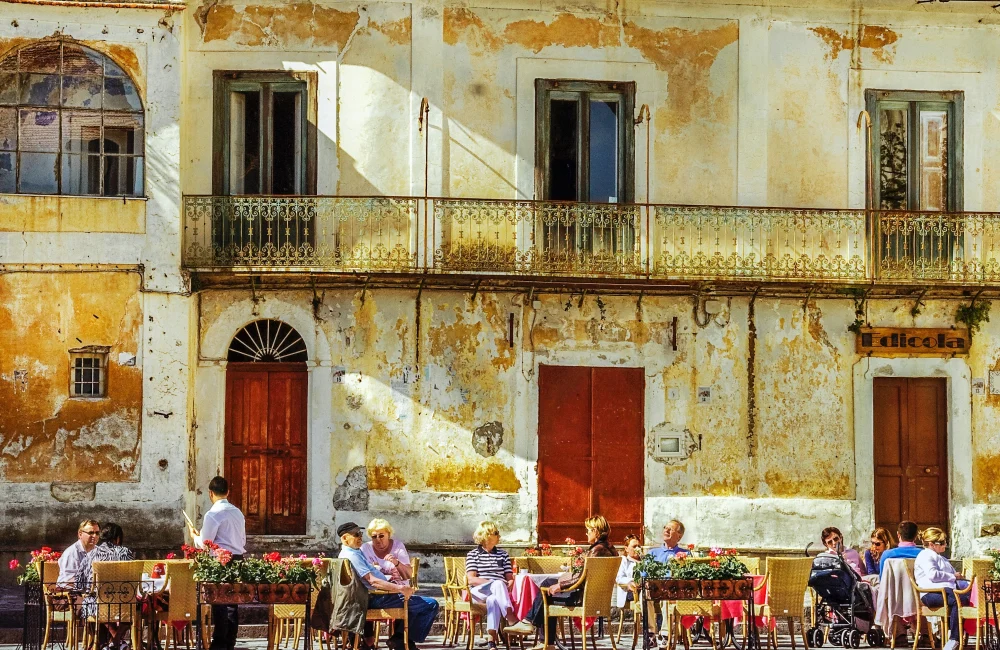
Ravello
A short drive inland from Amalfi lies Ravello, a town of particular interest to Swedish movie buffs. Reclusive Hollywood movie star Greta Garbo took a sabbatical year in 1938 to travel in Europe. That March, the New York Times revealed that she had been seen on the Amalfi Coast together with conductor and alleged lover Leopold Stokowski, who had just composed the music for Walt Disney’s latest blockbuster, Fantasia. The couple hid away in Villa Cimbrone, perched high on a cliff top on the outskirts of Ravello, 350m above sea level with a magnificent garden, pool and spectacular views. Today, Villa Cimbrone is one of the most beautiful and luxurious hotels in Ravello. And they’ve not forgotten the divine Garbo, whose visit is commemorated by a plaque here.
This small village has probably the Amalfi Coast’s most fantastic views, including the most famous, from the 13th century Villa Rufolo. Here, amid the scents and colors of the thousands of flowers and bushes, German composer Richard Wagner fell so deeply in love with the scenery that it provided him with the inspiration for the magic garden in the opera Parsifal. Other celebrities who’ve sought peace and beauty here include Winston Churchill, Jackie Kennedy, Sophia Loren and Mick Jagger.
Villa Cimbrone
If you have a sickeningly heavy wallet, this is the hotel for you. Book your stay here.

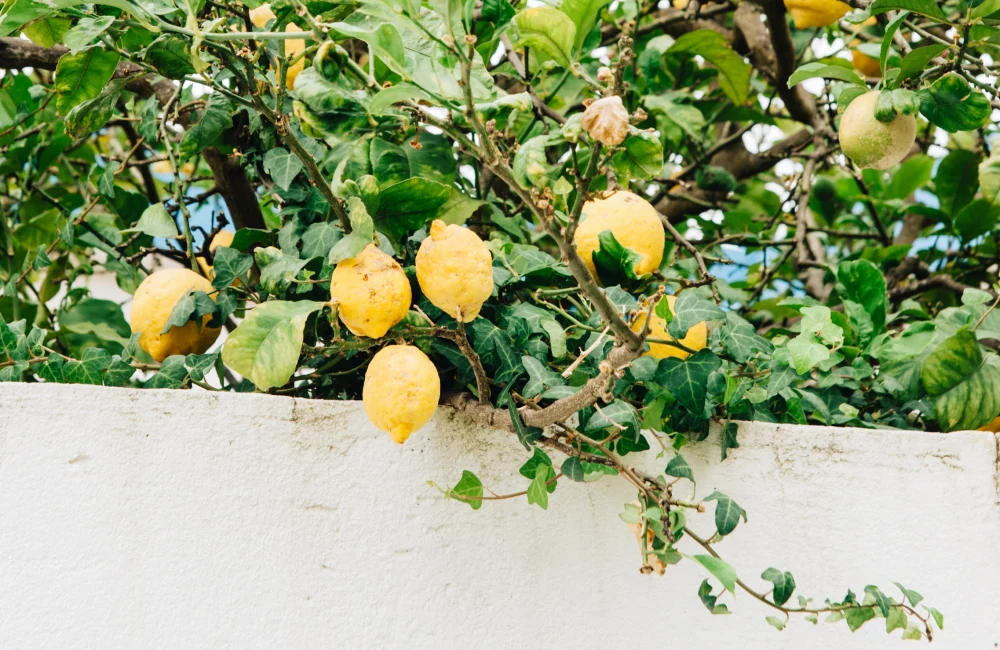
Vietri sul Mare
Back on the coast, heading east, we reach Vietri sul Mare, a town inextricably linked with lemons. Frankly, they are everywhere, in every shape and size – on murals, tiles, plates, in large boxes outside food stores – and in processed form in bottles. In other words, in the form of the Italian liqueur, limoncello.
In the heart of the main street, Via XXV Luglio, is Tresoli, a producer with a yellow-painted store that sells pretty much nothing but limoncello.
“The rediscovery of old tastes and flavors forms the basis of our products,” says Antonio Gallo, who runs production here together with his wife Carmela Esposito.
The pair are engineers who invested in the company two years ago, together with previous owner Alfonso Trezza, to develop the classic Italian digestif. Today their produce is sold throughout the country.
Vietri sul Mare, with a population of 8,000, may be the largest town on the coast, but it remains virtually unknown compared to the more famous towns along Amalfi Drive, and was recently dubbed part of “the undiscovered Amalfi Coast,” by CNN. A primary reason for this is that Vietri sul Mare has never really relied on tourism as a source of income – it’s better known for its ceramics production, that dates back to Roman times. The tiny town center is full of decorative tile stores that sell ceramics of all shapes and sizes, with hand-painted motifs, often (yes, you guessed it) of lemons. It makes for a perfect conclusion to an unforgettable journey, and despite the ubiquitous nature of the fruit around the town, there’s no chance of any bitter Amalfi Coast memories.
Dal Pescatore
The entrance looks like a staff door and the interior design with yellow plastic tablecloths is, frankly, quite ugly. But the diners are all Italian and both the food and prices are amazingly good. Read more here.

Text by Michael Jonsson